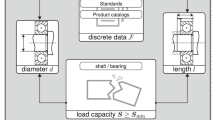Abstract
The design space of multi-stage transmissions is usually very large and heavily constrained. This places significant demands on the algorithm employed to search it, but successful optimization has the potential to yield considerably better designs than conventional heuristics, at the same time enabling a better understanding of the trade-offs between various objectives (such as service life and overall weight). Here we tackle a two-stage helical gear transmission design problem (complete with the sizing and selection of shafts, bearings, housing, etc.) using a two-phase evolutionary algorithm in a formulation that can be extended to include additional stages or different layouts.




Similar content being viewed by others
References
Abersek B, Flasker J, Balic J (1996) Expert system for designing and manufacturing of a gear box. Expert Syst Appl 11(3):397–405
Cohoon JP, Hegde SU, Martin WN, Richards DS (1991) Distributed genetic algorithms for the floor plan design problem. IEEE Trans Comput-Aided Des 10(4):483–492
DIN (1987) 3990 Teil 3 Tragfähigkeitsberechnung von Stirnrädern. Deutsches Institut Für Normung EV
Eldredge N, Gould SJ (1972) Punctuated equlibria: an alternative to phyletic gradualism. In: Schopf T (ed) Models in paleontology. Freeman Cooper, San Francisco
Ferguson GL, Robinson M Moynihan GP (1999) Expert system for selecting speed reduction components for a power transmission. J Manuf Syst 18(1):66–74
Gologlu C, Zeyveli M (2009) A genetic approach to automate preliminary design of gear drives. Comput Ind Eng 57:1043–1051
Hamada M, Martz HF, Reese CS, Wilson AG (2001) Finding near-optimal Bayesian experimental designs via genetic algorithms. Am Stat 55(3):175–181
Li R, Chang T, Wang J, Wei X (2008) Multi-objective optimization design of gear reducer based on adaptive genetic algorithm. In: 12th International Conference on Computer Supported Cooperative Work in Design
Lin Y, Shea K, Johnson A, Coultate J, Pears J (2009) A method and software tool for automated gearbox synthesis. In: Proceedings of the ASME International Design Engineering Technical Conferences and Computers and Information in Engineering Conference, 30 August–2 September, San Diego, California, USA, pp 1–11
Oh S, Yoon H (1998) An analysis of punctuated equilibria in simple genetic algorithms. Lect Notes Comput Sci 1363:195–206
Ray T, Liew KM (2003) Society and civilization: an optimization algorithm based on the simulation of social behavior. IEEE Trans Evol Comput 7(4):386–396
Ray T, Saini P (2001) Engineering design optimization using a swarm with an intelligent information sharing among individuals. Eng Optim 33(6):735–748
Talbi EG (2009) Metaheuristics: from design to implementation. Wiley, Hoboken
Thompson DF, Gupta S, Shukla A (2000) Tradeoff analysis in minimum volume design of multi-stage spur gear reduction units. Mech Mach Theory 35:609–627
Acknowledgements
The work of A. Sóbester has been supported by the Royal Academy of Engineering and the Engineering and Physical Sciences Research Council. Romanian Government grant PN II ID PCE 2007–2010, CNCSIS Code ID 1077 supported the work of the other authors.
Author information
Authors and Affiliations
Corresponding author
Rights and permissions
About this article
Cite this article
Tudose, L., Buiga, O., Ştefanache, C. et al. Automated optimal design of a two-stage helical gear reducer. Struct Multidisc Optim 42, 429–435 (2010). https://doi.org/10.1007/s00158-010-0504-z
Received:
Revised:
Accepted:
Published:
Issue Date:
DOI: https://doi.org/10.1007/s00158-010-0504-z




